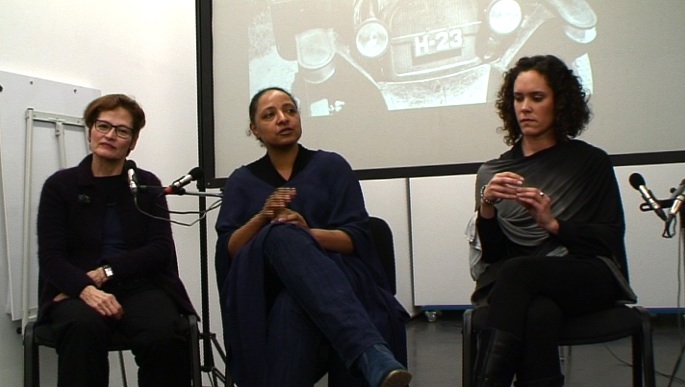
Timely Words: The Unfixed Projects Symposium

The aim of the symposium organized by Sara Blokland and Asmara Pelupessy, the curators of Unfixed Projects, was to explore photography’s relationship with changing notions of cultural histories, identities and representations. At the one-day event presentations were given in different formats, ranging from moderated conversations to an outstanding keynote lecture by cultural critic Kobena Mercer, a performance and a book presentation. Farid Tabarki, who managed to keep the conversations lively and public participation active, smartly moderated the symposium.
After the curators’ introduction, the first presentation was by the artist Charif Benhelima, who argued that the image of ‘the self’ is made by ‘third persons’, that is, neither the photographed subjects nor the photographers, but the persons who look at and interpret the images. Benhelima showed photographs published in his book Welcome to Belgium (2003). This book includes a selection of shots from the series of the same title, depicting migrants living in Brussels. As the artist told us, he had himself experienced similar circumstances. Benhelima did not further discuss his statement on the ‘third person’ and its role in the making of the history of the image. However, Kobena Mercer took up this aspect again in the keynote lecture, where he elaborated on the medium specificities of photography, thereby making the polysemantic qualities of photographs a central concern.

Mercer connected what he called ‘the surplus of photographic meaning’ to a contemporary exhibition practice, namely, the display of African photographs from the early to mid-twentieth century, which until recently were hidden in vernacular archives. One of his examples was the body of work by the Malian photographer Seydou Keïta, shown in Tate Modern in 2009. These exhibitions began to appear around the turn of the century, in the Netherlands most prominently with the exhibition of Malik Sidibé’s work in the Stedelijk Museum in 2001. Mercer used these exhibitions to illustrate ‘postcolonial belatedness’, which refers to the given that the photographic work is interpreted and valued much later than, and in a context different from where it was produced. A pendant to these exhibitions is the idea that they show modernity as a condition that took place all over the world at the same time, in rather site-specific ways. Photography might provide evidence for such ‘counter truths’, that is, truths counter to the dominant or canonical ones formulated by art historians like Rosalind Krauss, who seem to think of modernity as a European and American phenomenon.

Following upon Mercer, in his presentation the American artist Hank Willis Thomas demonstrated how racist views are mediated by means of visual culture, more particularly advertising, in the United States. For his work, Willis appropriated the language of the ads to expose the mechanisms of racism in visual culture. This resulted in images like the one of the black man’s torso with scars in form of the Nike logo on his muscular chest, thus an image that plays with the stereotype of the black athlete. Indeed, Willis’s work questions what is too often perceived as normal. His analysis of contemporary images in which stereotypes of blacks were replaced by stereotypes of Arabs was very illuminating.

The performance by Naro Snackey, as well as the artist’s talk by Otobong Nkanga, were two uncommon approaches towards the symposium’s topics. Snackey instructed her sister Desirée Snackey to move within the setting of her installation, consisting of dissected large-scale photographs scattered in the middle of the CBK’s exhibition space, while the public was dispersed and pushed to the fringes. Desirée acted as if she was alone in ‘her’ space, speaking aloud some thoughts the artist might have had during the making of her installation. The monologue expressed the pleasure and pain the artist went through while dissecting the images or, in other words, by making the artwork. In a similarly personal manner, Nkanga told the public about the memories she has of the landscape in which she grew up. Due to political circumstances, the artist’s family was forced to move between different parts of Nigeria when Nkanga still was a child. Standing on the podium while recalling her memories, she drew lines on a board as if to make up for the missing photographs of her childhood, which were destroyed during a house fire.
By and large the symposium’s balance between theory and practice was somewhat uneven. The artists’ presentations were interesting, but at times lacked the kind of inspiration that leads the participants’ thinking in yet unknown directions. Otobong Nkanga’s presentation and Kobena Mercer’s lecture compensated for a lot, though I could imagine that together with one or two more challenging discussion partners he would have been all the more inspiring.
Last but not least, it must be said that the Unfixed Projects curators have absolutely chosen the right moment to bring the relation between contemporary visual culture, racism and questions regarding multiculturalism back on the agenda of Dutch art institutions.
The Unfixed Symposium took place on 16 November 2010, at CBK Dordrecht.
Kerstin Winking


